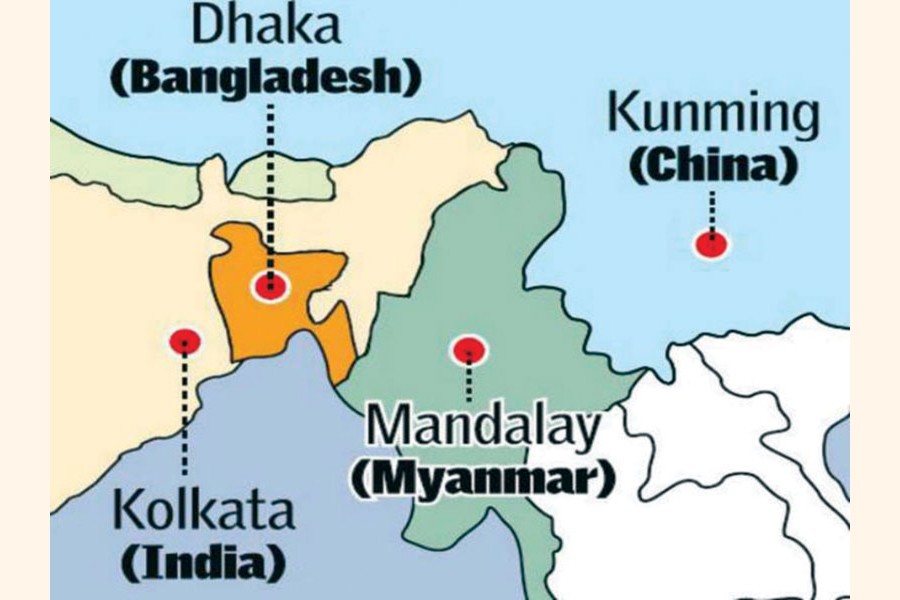
Published :
Updated :

The Asian Development Bank (ADB) has recently released an elaborate study report on how creating economic corridor can be highly beneficial for Bangladesh by way of opening multiple avenues for production, transportation and supply-chain facilitation. The term economic corridor, coined by the ADB in 1998, is now often used by economists and trade specialists to mean connecting economic agents along a defined geography. It provides connection between economic nodes or hubs, usually centred around urban landscapes, in which large amount of economic resources and actors are concentrated. It is here that economic corridors are believed to link the supply and demand sides of markets.
Economic corridors often feature integrated infrastructure such as highways, railroads and ports, and may link cities or countries. The corridor may be created to link manufacturing hubs, areas with high supply and demand, and manufacturers of value-added goods. Economic corridors not only connect regions and countries through transportation, but also emphasise building infrastructure network by establishing industrial clusters, thereby attracting investment and developing domestic and regional economy.
A well-functioning industrial cluster is likely to greatly stimulate economic development. As part of a comprehensive strategic development plan and integrated economic network, economic corridor is expected to integrate economic development in several regions within a country and between neighbouring countries. Due to the reduction of transportation and communication costs, smooth connection of various industrial chains, and the shortening of delivery time, some costs are saved during production. At the same time, economic corridor can also promote the development of other local industries, such as tourism and hotels.
As a development strategy, economic corridor is expected to drive the development of regional industries and create jobs. Tourism industry, hotel industry, catering industry and other service industries are the likely beneficiaries.
Ideally an economic corridor has three complementary components: (i) a trade and transport corridor; (ii) production clusters producing goods for both consumption in the domestic market and for international trade; and (iii) urban centres acting as the major market for goods from the production centres and goods imported through international gateways. They also act as a source of labour, technology, support services, knowledge and innovation.
The ADB study referred to above has expressed strong optimism that establishing an economic corridor connecting the lagging regions of northeast and southwest can ensure via Dhaka 2.6 times the output and generate 2.3 times the employment by 2050. The study points out that Bangladesh has its economic growth concentrated mainly in the Dhaka and Chattogram divisions, while other divisions lack adequate physical and social infrastructure to promote their growth. Currently, northeast and southwest Bangladesh are the key lagging regions in the country, said the study. It further says, as Bangladesh enters the next phase of economic growth, it needs to integrate the less developed regions into its development blueprint by way of an economic corridor. Creating an economic corridor can drive massive structural transformation to ensure that its development is sustainable and equitable, the study report adds.
In the light of its observations and findings, the ADB has conceptualised a Bangladesh Economic Corridor (BEC) running from the southwest region (Khulna division) to the northeast region (Sylhet and Mymensingh divisions) via Dhaka. The study says, if Bangladesh undertakes to establish such an economic corridor, the total combined output in the region is expected to increase from $32 billion in 2020 to $286 billion by 2050. The total employment generation in the corridor region is expected to be 15.7 million in 2025 and 71.8 million in 2050. The study also mentions that in the absence of the proposed corridor, the total output will be $110 billion in 2050 and total employment in the region would be 31.1 million by that year. The entire economic corridor conceptualised by the ADB encompasses 14 districts, covering 34 per cent of the total population.
Bangladesh currently has eight major trade gateways and the ADB report considers them highly beneficial if linked with the proposed corridor. There are: Mongla seaport, Payra seaport, Benapole land port, Bhomra land port (four in the southwest); Akhaura land port, Tamabil land port, Bibirbazar land port, Nakugaon land port (four in the northeast). The report states that while Mongla and Payra seaports provide sea route trade linkages with the world (currently contributing about 11 per cent of seaborne international trade), land ports in the region act as major trade gateways with India, contributing 36 per cent of Indo-Bangladesh trade. Hence, the corridor region has a natural advantage for international trade-dependent industries from the perspective of importing raw materials and/or exporting finished products.
The ADB report has also identified 56 railway projects to enable efficient rail movement in the region, 114 road projects to increase road density in the region by 38 per cent, 33 projects to improve inland water connectivity and 38 projects to address the bottleneck at export and import gateways. Four partially developed industrial clusters have been identified and 12 manufacturing industries were shortlisted for the whole corridor region. The industries are food processing, leather and footwear, textiles and ready-made garments, jute, nonmetallic mineral manufacturers, shipbuilding, furniture, transport equipment, pharmaceuticals, plastic products, rubber and rubber products, electrical and electronics machinery, and heavy machinery.
There is merit in the way the ADB study has dealt with the subject taking into account the country's entire geography, including among others the region-specific economic and trade potential as well as the laggings. However, the study appears to have relied a good deal on speculations, especially in respect of the feasibility of the industrial clusters and the gains from linkage building. Over and above, even a long-term execution of the plan seems rather ambitious given the funding concerns. We are yet to hear comments from the local experts. Let's wait and see how they find it.


 For all latest news, follow The Financial Express Google News channel.
For all latest news, follow The Financial Express Google News channel.